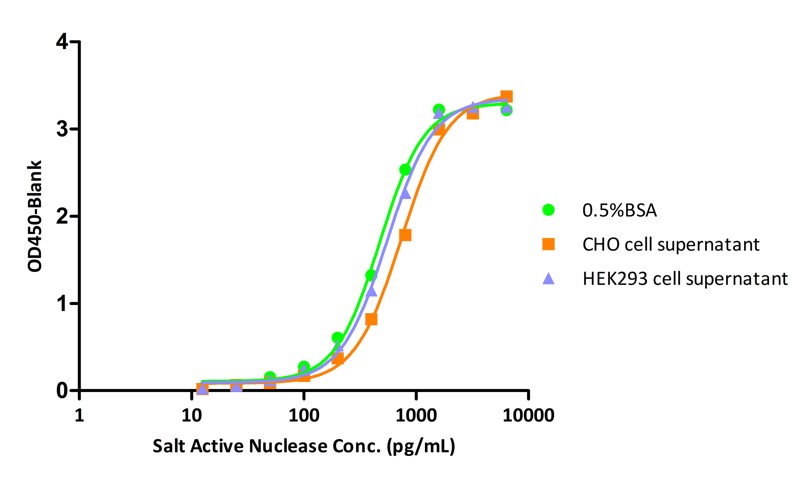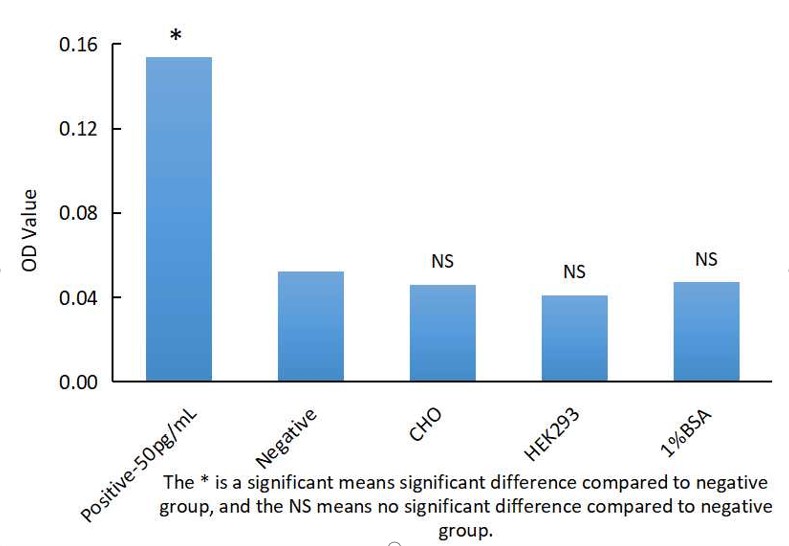产品参数(Product Specifications)
| Assay Type | Sandwich-ELISA |
| Analyte | Nuclease |
| Format | 96T(8×12 strips) |
| Reactivity | / |
| Regulatory Status | RUO |
| Sensitivity | <25pg/mL |
| Standard Curve Range | 25 pg/mL-800 pg/mL |
| Assay Time | 3 hr 20 min |
| Suitable Sample Type | For the quantitative determination the residue of nuclease in biologicals. |
| Sample volume | 100 uL |
产品概述(Product Overview)
Salt Active GENIUS™Nuclease ELISA Kit is based on ELISA sandwich method and designed for quantitative determination the residue of nuclease in biologicals. It contains Nuclease and a pair of antibodies against the eneyme, which are provided by ACROBiosystems. Results are obtained by four parameter logistic curve that were parallel to the standard curves obtained. The verification results indicate that this kit can be used for the quantitative determination of nuclease concentrations.
应用说明(Application)
The Salt Active GENIUS™ Nuclease ELISA Kit was developed for the detection and quantitative determination of nuclease in samples from downstream processing where nuclease is used as a process or purification aid.
It is for research use only.
重构方法(Reconstitution)
Please see Certificate of Analysis for details of reconstitution instruction and specific concentration.
存储(Storage)

组分(Materials Provided)
| ID | Components | Size |
| RES054-C01 | Pre-coated Anti-Nuclease Antibody Microplate | 1 plate(8×12 strips) |
| RES054-C02 | Salt Active Nuclease Standard | 5 μg |
| RES054-C03 | Biotin-Anti-Nuclease Antibody | 20 μg |
| RES054-C04 | Streptavidin-HRP | 50 μL |
| RES054-C05 | 10×Washing Buffer | 50 mL |
| RES054-C06 | 2×Dilution Buffer | 50 mL |
| RES054-C07 | Substrate Solution | 12 mL |
| RES054-C08 | Stop Solution | 7 mL |
原理(Assay Principles)
This assay kit employs a standard sandwich-ELISA format, providing a rapid detection of Nuclease. The kit consists of Pre-coated Anti-Nuclease Antibody Microplate and Nuclease Standard and Biotin-Anti-Nuclease Antibody and Streptavidin-HRP and buffers.
Your experiment will include 6 simple steps:
a) Bring all reagents to room temperature(20℃-25℃) before use.
b) Add your sample to the plate and take the Nuclease as standard. The samples and standard are diluted by Dilution Buffer.
c) Add the Biotin-Anti-Nuclease Antibody diluted by Dilution Buffer to the plate.
d) Wash the plate and add the Streptavidin-HRP diluted by Dilution Buffer to the plate.
e) Wash the plate and add TMB.
f) Stop the substrate reaction by adding diluted acid. Absorbance (OD) is calculated by the absorbance at 450 nm minus the absorbance at 630 nm to remove background disturbance before statistical analysis. The OD Value reflects the amount of bound protein.
典型数据-Typical Data Please refer to DS document for the assay protocol.

For each experiment, a standard curve needs to be set for each micro-plate, and the specific OD value may vary depending on different laboratories, testers, or equipments. The following example data is for reference only.
验证(Validation)
批内差异(Intra-Assay Statistics)
Three samples of known concentration were tested ten times on one plate to assess intra-assay precision, Intra-Assay Precision CV≤15%.

批间差异(Inter-Assay Statistics)
Three samples of known concentration were tested in three separate assays to assess inter-assay precision, Inter-Assay Precision CV≤15%.

回收率(Recovery)
Three Salt Active Nuclease with different concentrations were tested to calculate the recovery rate.

干扰效应(Interference effect)
resDetect™ Salt Active GENIUS™ Nuclease ELISA Kit (Residue Testing) (Cat. No. RES-A054) can detect the Salt Active Nuclease in different culture supernatant with similar curve and sensitivity.

专属性(Specificity)
resDetect™ Salt Active GENIUS™ Nuclease ELISA Kit (Residue Testing) (Cat. No. RES-A054) can detect the Salt Active Nuclease from different culture supernatant and was free from the matrix effects.

背景(Background):Nuclease
Nucleases are enzymes that degrade nucleic acids, either DNA or RNA. It has been used for the preparation of nuclear extracts by digesting DNA and releasing nuclear proteins intimately associated with DNA. It has also been designed for removing RNA and DNA in biotechnological processing. Thus, the amount of residual nuclease in biological products should be detected and limited.























































 膜杰作
膜杰作 Star Staining
Star Staining











